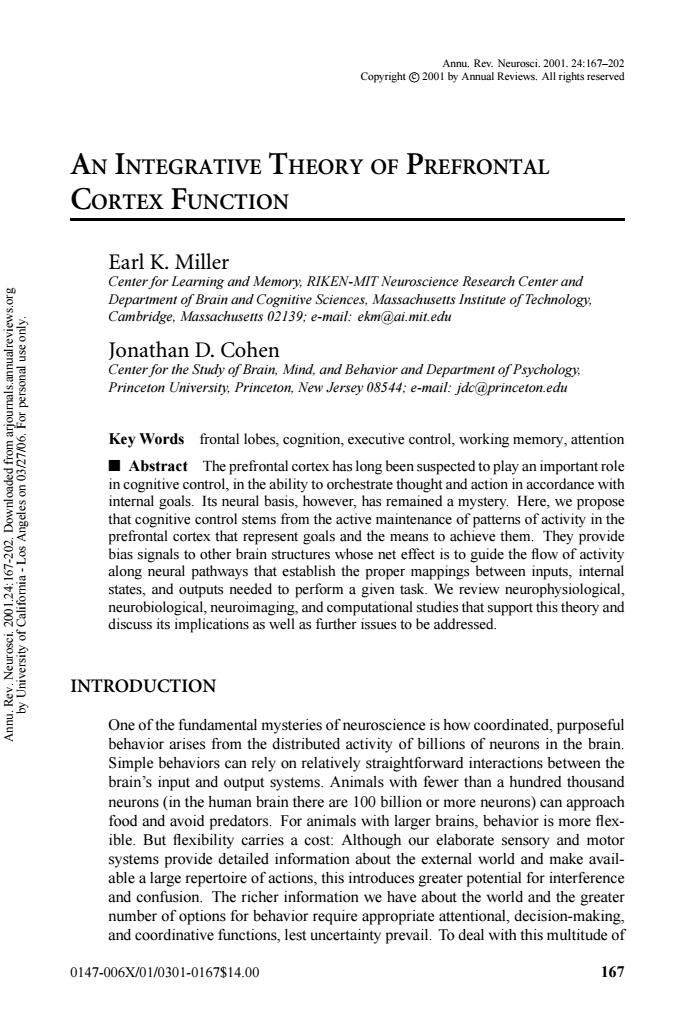正在加载图片...

AN INTEGRATIVE THEORY OF PREFRONTAL CORTEX FUNCTION Earl K.Miller Center for Learning and Memory.RIKEN-MIT Neuroscience Research Center and Department of Brain and Cognitive Sciences,Massachusetts Institute of Technology. Cambridge,Massachusetts 02139:e-mail:ekm@ai.mit.edu Jonathan D.Cohen Center for the Study of Brain,Mind,and Behavior and Department of Psychology. Princeton University.Princeton.New Jersey 08544:e-mail:jdc@princeton.edu Key Words frontal lobes,cognition,executive control,working memory,attention Abstract The prefrontal cortex has long been suspected to play an important role in cognitive control,in the ability to orchestrate thought and action in accordance with internal goals.Its neural basis,however,has remained a mystery.Here,we propose that cognitive control stems from the active maintenance of patterns of activity in the prefrontal cortex that represent goals and the means to achieve them.They provide bias signals to other brain structures whose net effect is to guide the flow of activity along neural pathways that establish the proper mappings between inputs,internal states,and outputs needed to perform a given task.We review neurophysiological neurobiological,neuroimaging,and computational studies that support this theory and discuss its implications as well as further issues to be addressed. INTRODUCTION One of the fundame tal,pur oseful behavio arises from the distrib ted activity of billions of neurons in the brair Simple behaviors can rely on relatively straightforward interactions between the brain's input and output systems.Animals with fewer than a hundred thousand neurons(in the human brain there are 100 billion or more neurons)can approach food andavoid predators.For animals with a arger brains,behavior is more flex ible.But flexibility carries a cost:Although our elab nsory and moto systems provide detailed information about the external world and make avail able a large repertoire of actions,this introduces greater potential for interference and confusion.The richer information we have about the world and the greater number of options for behavior require appropriate attentional,decision-making and coordinative functions,lest uncertainty prevail.To deal with this multitude of 0147-006X/01/0301-0167514.00 167 P1: FXZ January 12, 2001 14:38 Annual Reviews AR121-07 Annu. Rev. Neurosci. 2001. 24:167–202 Copyright c 2001 by Annual Reviews. All rights reserved AN INTEGRATIVE THEORY OF PREFRONTAL CORTEX FUNCTION Earl K. Miller Center for Learning and Memory, RIKEN-MIT Neuroscience Research Center and Department of Brain and Cognitive Sciences, Massachusetts Institute of Technology, Cambridge, Massachusetts 02139; e-mail: ekm@ai.mit.edu Jonathan D. Cohen Center for the Study of Brain, Mind, and Behavior and Department of Psychology, Princeton University, Princeton, New Jersey 08544; e-mail: jdc@princeton.edu Key Words frontal lobes, cognition, executive control, working memory, attention ■ Abstract The prefrontal cortex has long been suspected to play an important role in cognitive control, in the ability to orchestrate thought and action in accordance with internal goals. Its neural basis, however, has remained a mystery. Here, we propose that cognitive control stems from the active maintenance of patterns of activity in the prefrontal cortex that represent goals and the means to achieve them. They provide bias signals to other brain structures whose net effect is to guide the flow of activity along neural pathways that establish the proper mappings between inputs, internal states, and outputs needed to perform a given task. We review neurophysiological, neurobiological, neuroimaging, and computational studies that support this theory and discuss its implications as well as further issues to be addressed. INTRODUCTION One of the fundamental mysteries of neuroscience is how coordinated, purposeful behavior arises from the distributed activity of billions of neurons in the brain. Simple behaviors can rely on relatively straightforward interactions between the brain’s input and output systems. Animals with fewer than a hundred thousand neurons (in the human brain there are 100 billion or more neurons) can approach food and avoid predators. For animals with larger brains, behavior is more flexible. But flexibility carries a cost: Although our elaborate sensory and motor systems provide detailed information about the external world and make available a large repertoire of actions, this introduces greater potential for interference and confusion. The richer information we have about the world and the greater number of options for behavior require appropriate attentional, decision-making, and coordinative functions, lest uncertainty prevail. To deal with this multitude of 0147-006X/01/0301-0167$14.00 167 Annu. Rev. Neurosci. 2001.24:167-202. Downloaded from arjournals.annualreviews.org by University of California - Los Angeles on 03/27/06. For personal use only